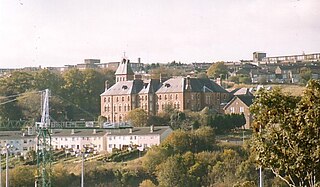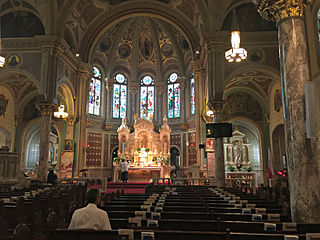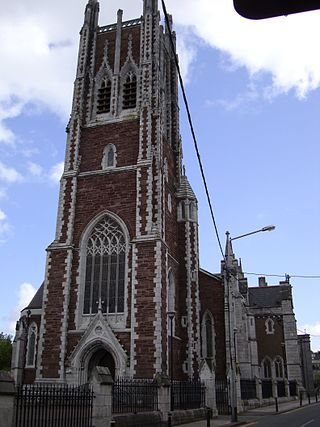
Sacred Heart Cathedral, located in Davenport, Iowa, United States, is a Catholic cathedral and a parish church in the Diocese of Davenport. The cathedral is located on a bluff overlooking the Mississippi River to the east of Downtown Davenport. It is listed on the National Register of Historic Places as part of the Sacred Heart Roman Catholic Cathedral Complex. This designation includes the church building, rectory, and the former convent, which was torn down in 2012. The cathedral is adjacent to the Cork Hill Historic District, also on the National Register. Its location on Cork Hill, a section of the city settled by Irish immigrants.

Saint Finbar, Finbarr, Finnbar, or Finnbarr, in Irish Fionnbharra, very often abbreviated to Barra, was Bishop of Cork and abbot of a monastery in what is now the city of Cork, Ireland. He is patron saint of the city and of the Diocese of Cork. His feast day is 25 September.

Douglas is a suburb, with a village core, in Cork city, Ireland. Douglas is also the name of the townland, Roman Catholic parish, Church of Ireland parish and civil parish in which it is contained.

St. Stanislaus Kostka Church is an independent Catholic church located in the city of St. Louis, Missouri. Formerly a parish belonging to the Catholic Church, it was established in 1880 to serve the Polish community in the Archdiocese of St. Louis. The parish is maintained and managed by its parishioners as a 501(c)3 not-for-profit corporation.

Farranferris, also known as St Finbarr's College, was a secondary school in Cork City, Ireland. It opened in 1887, closed in 2006, and was an important institution in the twentieth century history of the city.
Cornelius "Con" Lucey (1902–1982) was a Roman Catholic Bishop of Cork and Ross.

The Honan Chapel is a small Catholic church built in the Hiberno-Romanesque revival style on the grounds of University College Cork, Ireland. Designed in 1914, the building was completed in 1916 and furnished by 1917. Its architecture and fittings are representative of the Celtic Revival movement and evoke the Insular art style prevalent in Ireland and Britain between the 7th and 12th centuries.
St Stanislaus College was a Jesuit boys boarding school, novitiate and philosophy school, in Tullabeg, Rahan, County Offaly. St Carthage founded a monastery of 800 monks there in 595 before founding his monastery in Lismore. The Presentation Sisters also have a convent in Rahan, Killina, which was founded at the same time as the Jesuits founded St Stanislaus College.

The Church of St Mary and St John is the older of two Roman Catholic churches in the town of Ballincollig, County Cork, Ireland. The church was built in the 1860s, funded by donations from the local people of the time, and officially opened on 28 October 1866. The church is in a Gothic Revival style, combined with some features of other periods. It is built of ashlar limestone with roof slates.
John Butler, 12th Baron Dunboyne was an Irish clergyman and aristocrat, Roman Catholic Bishop of Cork and Ross. In order to advance his temporal title and marry he became, as of 2004, the only authenticated apostate in the Catholic hierarchy in Ireland
Michael G. O'Brien was an Irish Roman Catholic priest who was also a noted hurling coach and manager.

The Cathedral of the Most Holy Trinity is the cathedral church of the Roman Catholic Diocese of Waterford and Lismore located in Barronstrand Street, Waterford City, Ireland. The cathedral is the oldest post-Reformation Catholic cathedral in Ireland, pre-dating the Roman Catholic Relief Act 1829 by some 36 years.
Francis Moylan (1735–1815) was the Roman Catholic Bishop of Cork, having first served as Bishop of Bishop of Ardfert and Aghadoe in Kerry.

St. Stanislaus Church in Meriden, Connecticut is a Roman Catholic church originally established in 1891 and dedicated to the Bishop of Kraków, Stanislaus of Szczepanów, an 11th-century Polish Saint. St. Stanislaus's is the third oldest Polish-American Roman Catholic parish in New England and the oldest in the Archdiocese of Hartford. In 2017, Saint Stanislaus parish merged with the nearby Polish-American parish SS. Peter and Paul Parish in Wallingford to form St. Faustina Parish.

St. Stanislaus Parish, designated for Polish immigrants in New Haven, Connecticut, United States, was founded on December 28, 1901. It is one of the Polish-American Roman Catholic parishes in New England in the Archdiocese of Hartford.
St. Stanislaus Kostka Church in Wilmington, Delaware, United States, was founded November 23, 1913, as a Roman Catholic Church on the East Side of Wilmington to serve the needs of a growing Polish immigrant community. The Church was a part of the Diocese of Wilmington, until its closure on February 15, 2009.

The Cathedral of Saint Mary and Saint Anne, also known as Saint Mary's Cathedral, The North Cathedral or The North Chapel, is a Roman Catholic cathedral located at the top of Shandon Street in Cork, Ireland. It is the seat of the Bishop of Cork and Ross, and the mother church of the Roman Catholic Diocese of Cork and Ross. Its name derived from the fact that it encompassed the ecclesiastical parish of St. Mary and the civil parish of St. Anne.

South Parish is the name given to both a Roman Catholic parish of Cork City and to the residential area contained within it.

John Baptist Sleyne was Roman Catholic Bishop of Cork and Cloyne and Apostolic Administrator of the diocese of Ross, who was an enthusiastic patron of the Gaelic language and culture, and an advocate of the severely repressed Roman Catholic population, in Ireland during the early period of the Penal Laws. He was one of only two bishops to minister in Ireland at the end of the 17th century. Sleyne was very learned in languages and moral theology, and had traveled widely. He was known to and had interactions with kings, queens, popes and wider cultural and religious establishment throughout Ireland and Europe. Because Sleyne "remain[ed] in the kingdom contrary to the [penal] law", of the time, he went into hiding. He was eventually brought before the courts in 1698 and spent five years in prison in Cork Gaol. During his time as Bishop, both as fugitive and prisoner, Sleyne ordained many priests and consecrated several bishops in Ireland. He was eventually exiled to Portugal, on 11 February 1703, where he was given shelter in the Irish Dominican Convento do Bom Sucesso, Lisbon. He died in Portugal on 16 February 1712, aged 74 years and is buried at the altar of the Sacred Heart in the Church of Nossa Senhora do Bom Sucesso.

St. Catherine of Siena Catholic Church is a Roman Catholic church in Wake Forest, North Carolina, a suburb of Raleigh.
















